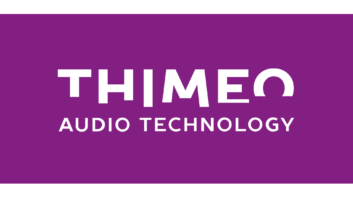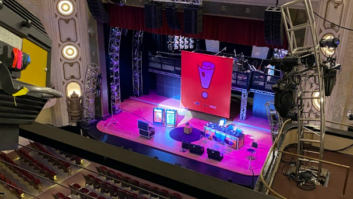I previously authored an article in Radio World Engineering Extra (April 18, 2012) comparing the performance of high- and low-end analog oscilloscopes to a very inexpensive digital storage oscilloscope or DSO. At the time, the price/performance leader for entry-level products was China-based Rigol with their DS-1102E at $400.
It has been a very popular scope, boasting two 100 MHz channels and lots of built-in measurement and math capability. Compared to its older analog brethren it produced a brighter, easier-to-read screen, and replay from storage memory was far superior to analog storage CRT technology. But it wasn’t without its limitations.
The LCD vector waveform display’s resolution was not as good as an analog CRT. Waveforms had obvious jaggies and it did not have the look of phosphor as there was no brightness information that the eye can see from the refresh or scan rate of conventional electron beam writing. The one-button automatic setup mode — though a timesaver, especially for younger folks who never before used a scope — wasn’t always successful in capturing a waveform.
DISPLAYS
The big names in test equipment, back in 2008, had introduced phosphor-like DSO displays, but these were expensive instruments costing far more than analog scopes available on the used equipment market, sometimes for pennies on the dollar.
Recently, other Chinese-based manufacturers have come along to challenge Rigol for the entry-level or low-cost scope market. You can buy a Hantek DS 050202P-INT dual-channel 200 MHz bandwidth widescreen DSO for just shy of $300! While it gives you 200 MHz analog input bandwidth, the sample rate is limited to 1 GSps, which is considered insufficient for 200 MHz. Its channel noise is average for low-end DSOs. But it does come with a good array of features. It is an excellent bargain buy.
GW Instek offers the GDS-1102B DSO with 100 MHz bandwidth for $404; it has a much higher waveform update rate but the same 1 GSps real-time sample rate. It also has a better display capable of 256 grades in a special color grade mode and has a phosphor style display that gives the waveform a more analog look. The GDS-1104B gives you four input channels for $695.
Why would you want more than two channels? If you are troubleshooting digital circuits, quite often you may need to look at two inputs that will cause one specific output to change. And sometimes that output may be split into two logic outputs. A four-channel DSO may therefore be handy.
Keep in mind that unless you buy a much more costly high-end instrument, every input channel shares the DSP and thus reduces the available sample rate, lowering bandwidth and accuracy. Two channels will reduce the acquisition rate to 500 MSps. Lower sample rates will create greater aliasing products.
Another issue is dead time between samples and sweeps. It can be long enough to make it impossible to detect short transient pulses, especially one with a random slow repetition rate. It might never be captured in the DSO’s memory. Many pricy high-end DSOs cannot catch quick transient pulses. So don’t expect low-cost instruments to be any better.
But wait, there is one recent model that has demonstrated its ability to capture that elusive pulse. The Siglent SDS-1102X two-channel 100 MHz DSO will capture them with its 14M point memory depth. And its LCD phosphor screen emulating display is gorgeous. The price is $424 and, as I write this, includes their serial bus decoding firmware option package for troubleshooting UART devices, CAN Bus and other data protocols.
In comparison, if you want serial decoding and digital phosphor display in a Tektronix product you’ll need at least the DPO-2000B, priced at $2,130 compared to $424 for the similarly equipped Siglent, which has a far higher capture rate and is more likely to find brief glitches.
So, what do you get for a 500 percent higher price? The menus and control layout are better on the Tektronix and you get more context related on screen help. The controls feel somewhat more responsive and there are fewer if any firmware bugs. The physical build is excellent.
On the other hand, the Siglent is also packed with high-end features and performs in some ways better than many of the high-end name brand scopes. For the price it is a remarkable instrument, well worth owning. In fact, if you have a large shop you could afford to buy several for your staff without breaking a sweat.
In comparing the older-technology Rigol DS-1102E, which retails for between $350–400, close to the cost of the Siglent SDS-1102X, it’s like apples and oranges. Basic functionality is the same. But the Siglent can decode serial data pulses, has more switches and rotary encoders, so you do not have to share controls with the two input channels. The display is much brighter and larger. The digital phosphor intensity modulation paints far more analog-like waveforms with much greater visual fidelity. And the manual controls seem to work better.
ENVELOPES
One basic broadcast use of an oscilloscope is to determine peak AM modulation for calibration purposes. The Rigol can hardly sync to the envelope at all and cannot show multiple samples of the 1 kHz modulation envelope (Fig. 4, left instrument).


Fig. 1
Photos by Ira WilnerFig. 2
The Siglent can be dialed to show any number of envelope peaks. And it is far easier to judge carrier pinch-off with its display (Fig. 4, right instrument). With the far greater sample rate, the Siglent’s FFT display, frequency domain, as in a spectrum analyzer, is much more accurate than the Rigol.
The Rigol in automatic mode doesn’t choose the correct screen mode to show the modulated carrier waveform (see Fig. 1), while the Siglent does (see Fig. 2). The correct screen display mode is persistence on. The Siglent with its Super Phosphor display (see Fig. 3) presents a view identical to what you would expect from an analog CRT scope.

Fig. 3

Fig. 4

Fig. 5
Both scopes look at the RF carrier frequency as the signal to synchronize to. If you want to see the AM envelope you have to force both instruments to sweep at a much slower rate than chosen and do some low-pass filtering of the sync signal to help them lock onto the modulation rate, in this instance 1 kHz. Neither scope had 100 percent sync stability. But neither will an analog scope (Fig. 4).
The Rigol showed a firmware issue in that it could not display more than one cycle of the envelope. When attempting to do so it would revert to the previous image above at a low repetition rate. The Siglent’s sweep time could be slowed to provide any number of 1 kHz amplitude excursions. The RF generator was set to approximately 98 percent modulation.
The displays differ in other ways. See Figs. 5 and 6. Besides the obvious brightness modulation mimicking an analog CRT scope’s trace, the Siglent’s image detail has far fewer jaggies, a much smoother display. And the overall noise is much lower too. Both scopes are displaying a 170 MHz signal, excellent for instruments rated for only 100 MHz.


Fig. 6Fig. 7
The noise jitter and jaggies are very prominent on the Rigol at high gain with a 149 MHs signal. While the same signal on the Siglent (Fig. 7) is very clean. I chose a demanding signal beyond the normal specifications of the instruments to illustrate the difference in actual maximum sample storage rate, display resolution and noise.
Also note the frequency readout of the Rigol is quite inaccurate. The actual frequency (see Fig. 6) was exactly 149.000 MHz because the generator was locked to a Rubidium atomic oscillator.
Finally, I tested the bandwidth of both scopes by applying test signals at –20 dBm at 50 ohms. The standard for bandwidth is the –3 dB rolloff point. The Rigol was down 2.1 dB at 100 MHz compared to 1 MHz, which is excellent while the Siglent was down 2.5 dB, also very good. However, the Rigol was down 3 dB at 129 MHz while the Siglent was down 3 dB at 149 MHz, which is excellent.
Product Capsule
SIGLENT SDS-1102X
Two-Channel 100 MHz DSO
Thumbs Up
+ Large super phosphor color display looks like an analog CRT scope, providing same waveform image detail
+ Automatic waveform acquisition modes are excellent
+ Display crisp and noise-free
+ Waveform memory depth and max sample rates capable of capturing elusive transients, something more expensive instruments fail to do
+ Fan very quiet
+ Numerous math functions
Thumbs Down
– Has only a single time-base shared by both channels
– Has only two fixed trigger filters, low-pass and high-pass
– Supplied switched 1X/10X probes are flimsy
– Firmware is a bit buggy and may require restart to clear on occasion
For information, contact Siglent Technologies America in Ohio at (877) 515-5551 or visit http://siglentamerica.com.
Analog oscilloscopes might still be a good choice for those without much engineering and measurement experience as they are easier to operate and the controls are more intuitive. For those who desire the benefits of a storage display, you cannot beat the capability of modern digital storage oscilloscopes. Not only can they provide clearer views but the onscreen measurement capability for time and amplitude yields greater accuracy than their analog counterparts. An entry-level price can now buy you a better digital scope with features and performance rivaling those of previous mid- to high- end models. But be prepared for some minor bugs since modern DSOs are software-driven instruments.
Purchased a recently introduced product and want to review it? Email[email protected]and let us know.
Ira Wilner has been the chief engineer for the Monadnock Broadcasting Group of Saga Communications for 15 years and is the owner of contract broadcast engineering company Wilner Associates.












